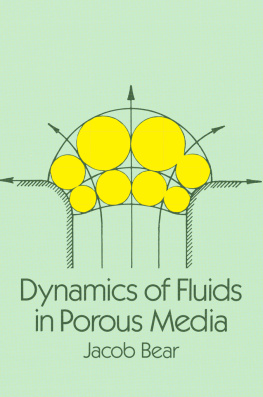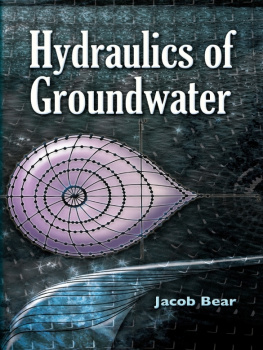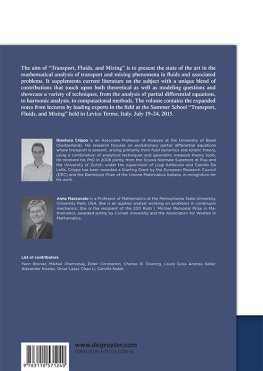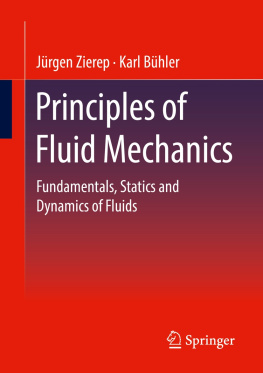Bear - Dynamics of fluids in porous media
Here you can read online Bear - Dynamics of fluids in porous media full text of the book (entire story) in english for free. Download pdf and epub, get meaning, cover and reviews about this ebook. City: New York, year: 1988, publisher: Dover, genre: Children. Description of the work, (preface) as well as reviews are available. Best literature library LitArk.com created for fans of good reading and offers a wide selection of genres:
Romance novel
Science fiction
Adventure
Detective
Science
History
Home and family
Prose
Art
Politics
Computer
Non-fiction
Religion
Business
Children
Humor
Choose a favorite category and find really read worthwhile books. Enjoy immersion in the world of imagination, feel the emotions of the characters or learn something new for yourself, make an fascinating discovery.
Dynamics of fluids in porous media: summary, description and annotation
We offer to read an annotation, description, summary or preface (depends on what the author of the book "Dynamics of fluids in porous media" wrote himself). If you haven't found the necessary information about the book — write in the comments, we will try to find it.
Bear: author's other books
Who wrote Dynamics of fluids in porous media? Find out the surname, the name of the author of the book and a list of all author's works by series.
Dynamics of fluids in porous media — read online for free the complete book (whole text) full work
Below is the text of the book, divided by pages. System saving the place of the last page read, allows you to conveniently read the book "Dynamics of fluids in porous media" online for free, without having to search again every time where you left off. Put a bookmark, and you can go to the page where you finished reading at any time.
Font size:
Interval:
Bookmark:
in porous media
Jacob Bear
Department of Civil Engineering
TechnionIsrael Institute of Technology, Haifa
DOVER PUBLICATIONS, INC.
New York
Copyright 1972 by American Elsevier Publishing Company, Inc.
All rights reserved.
This Dover edition, first published in 1988, is an unabridged, corrected republication of the work first published by the American Elsevier Publishing Company, Inc., New York, 1972, in its Environmental Science Series.
Library of Congress Cataloging-in-Publication Data
Bear, Jacob.
Dynamics of fluids in porous media / by Jacob Bear.
p. cm.
Reprint. Originally published: New York: American Elsevier
Pub. Co., 1972. Originally published in series: Environmental science series (New York, 1972 ). With corrections.
Bibliography: p.
Includes index.
ISBN-13: 978-0-486-65675-5
ISBN-10: 0-486-65675-6
1. Fluid dynamics. 2. Groundwater flow. I. Title.
TA357.B38 1988
620.1'064dc19
87-34940
CIP
Manufactured in the United States by Courier Corporation
65675609
www.doverpublications.com
This book is dedicated to
my dear friend, Colonel S. Alton,
who fell defending his country
in the Six Days War (June 511, 1967).
Contents
Jacob Bear
Jacob Bear is one of the worlds foremost hydrologists. Presently, he has 67 publications to his credit and is Professor of Hydrology and Deputy Vice President at the Technion-Israel Institute of Technology in Haifa, where he has also been head of both the Hydraulics Laboratory and the Water Resources Research Center. In addition to his years at the Technion, Dr. Bear has taught and developed courses in hydrology at the Massachusetts Institute of Technology, the University of California at Berkeley, the University of Wisconsin, Princeton University, and New Mexico Institute of Mines and Technology. He has also been a planning engineer, a hydrologist, and a consultant on hydrology to Water Planning for Israel Ltd., the Ministry of Agriculture of Israel, and, most recently, Yalon-Balasha, consultants and engineers on large scale development projects in Iran and the Benue Plateau in Nigeria.
A native of Israel, Dr. Bear graduated with honors from the Technion in 1953, where he also received his Dipl. Eng. and M.Sc. degrees in 1954 and 1957 respectively. In 1960 he obtained his Ph.D at the University of California at Berkeley. His studies abroad include scholarships at the Hague and the University of California at Berkeley, and a three-month U.N. scholarship for a study tour in the Netherlands, France and the U.S.A.
Active in many related fields, Dr. Bears memberships include the Israel Association of Geodesy and Geophysics, the International Association for Hydraulic Research, the National Committee of the Hydrological Decade, the editorial board of the Israel Journal of Earth Sciences, and Israels Water Planning Committee. He has been chairman of the Hydrology Section of Israel Association of Geodesy and Geophysics, the National Committee of the Hydrological Decade, and the Section of Flow through Porous Media of the International Association for Hydraulic Research. A speaker at numerous international conferences, Dr. Bears lectures include discussions on intercepting fresh water above the interface in a coastal aquifer, the optimal yield of an aquifer, hydrodynamic dispersion in porous media, immiscible displacement in fractured porous media, and hydrologic education in Israel.
Preface
This book is an attempt to present, in an ordered manner, the theory of dynamics (actually, also of statics) of fluids in porous media, as applicable to many disciplines of science and engineering. For some years I have taught courses on flow through porous media, and have treated this subject as a part of other courses, such as ground water hydrology, while at the TechnionIsrael Institute of Technology, at M.I.T. where I spent my sabbatical leave (19667), and at several other institutions. I have felt the lack of a suitable textbook on this subject. Ideally, such a text should start from first principles of fluid mechanics and mechanics of continua, should show the passage from the microscopic to the macroscopic level of treatment, should emphasize the special features of porous media, establish the macroscopic theory and then show how it is applied to cases of practical interest.
It is rather surprising that in spite of its importance in many fields of practical interest, such as petroleum engineering, ground water hydrology, agricultural engineering and soil mechanics, so small number of treatises is available on fluids in porous media. This circumstance is even more surprising in view of the vast amount of literature published on the subject in a number of scientific and engineering journals. Although dynamics of fluids in porous media could become an interesting interdisciplinary course serving several departments, I believe that the relatively small number of courses offered by universities on the subject is due in part to lack of a suitable textbook. To overcome this lack I prepared notes for my own classes, which I present here in the form of a book, hoping that it will serve others in a similar situation.
The book is designed primarily for advanced undergraduate students and for graduates in fields such as ground water hydrology, soil mechanics, soil physics, drainage and irrigation engineering, sanitary engineering, petroleum engineering and chemical engineering, where flow through porous media plays a fundamental role. The book, I hope, will also serve the needs of scientists and engineers already active in these fields, who require a sound theoretical basis for their work. The emphasis in this book is on understanding the microscopic phenomena occurring in porous media and on their macroscopic description. The reader is led to grasp the meanings of the various parameters and coefficients appearing in the macroscopic descriptions of problems of flow through porous media, and their actual determination, as well as the limitations and approximations inherent in their description. In each case, the objective is to achieve a clear formulation of the flow problem considered and a complete mathematical statement of it in terms of partial differential equations and a set of initial and boundary conditions. Once a flow problem is stated properly in mathematical terms, three methods of solution are possible in principle: analytic solution, numerical solution aided by high speed digital computers and solution by means of laboratory models and analogs. All three tools are described in this book. Typical examples of analytic solutions are scattered throughout the book, but no attempt is made to present a collection of a large number of solved problems. The principles of the numerical method of solution are presented, and a detailed description is given of laboratory models and analogs, their scaling and applications.
Mathematics is employed extensively and the reader is expected to have a good background in advanced engineering mathematics, including such subjects as vector analysis, Cartesian tensor analysis, partial differential equations and elements of the theory of functions.
No attempt is made to give a complete citation of all published literature or to indicate the first author on a particular subject. References selected for citation are those I think represent a more important point of view, are more appropriate from the educational point of view or are more readily available for the average reader.
Obviously a single book, even of this size, cannot include everything related to the subject treated. Although we consider porous media in general, the discussion is limited to media with relatively large pores, thus excluding clays and media with micropores or colloidal-size particles. Similarly, chemical and electrochemical surface phenomena are excluded. The discussion is restricted to Newtonian fluids.
Font size:
Interval:
Bookmark:
Similar books «Dynamics of fluids in porous media»
Look at similar books to Dynamics of fluids in porous media. We have selected literature similar in name and meaning in the hope of providing readers with more options to find new, interesting, not yet read works.
Discussion, reviews of the book Dynamics of fluids in porous media and just readers' own opinions. Leave your comments, write what you think about the work, its meaning or the main characters. Specify what exactly you liked and what you didn't like, and why you think so.












